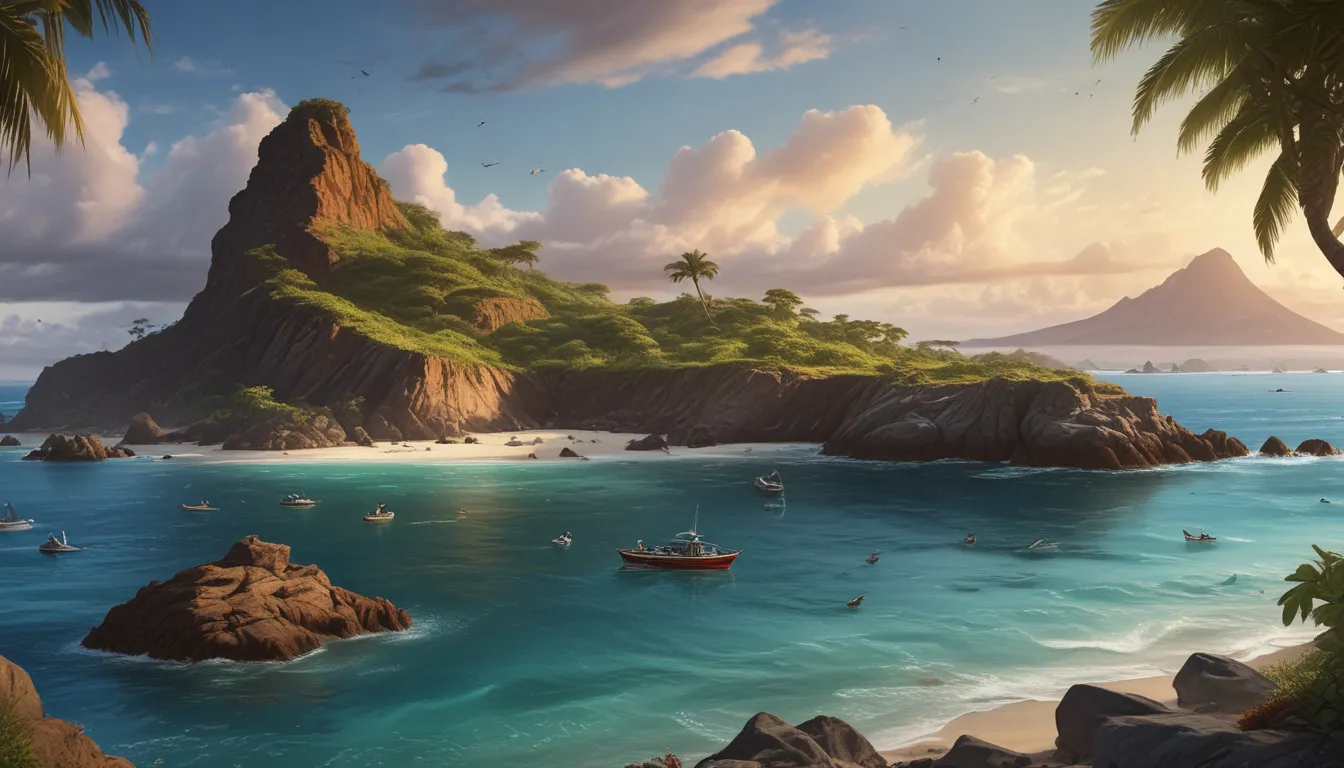The pictures we use in our articles might not show exactly what the words say. We choose these pictures to make you interested in reading more. The pictures work together with the words but don’t take their place. The words still tell you the important facts.
Nestled in the vast expanse of the Pacific Ocean, approximately 1,000 kilometers off the coast of Ecuador, lie the Galápagos Islands. This remote archipelago, with its isolated paradise, unique ecosystems, and captivating wildlife, has long been a source of fascination for scientists, researchers, and nature enthusiasts alike. The Galápagos Islands are not just a tourist destination but also a living laboratory that has influenced the field of evolutionary biology in profound ways.
Unveiling the Astonishing Galápagos Islands
The Galápagos Islands hold a wealth of astonishing facts that highlight their natural wonders and allure. From the iconic giant tortoises to the diverse marine life, and from the volcanic landscapes to ongoing conservation efforts, these islands are truly extraordinary in every sense.
Discovering the Unique Wildlife
One of the defining features of the Galápagos Islands is their unique wildlife, including the famous Galápagos giant tortoise and marine iguanas. These species are exclusive to the islands and cannot be found anywhere else in the world, making the archipelago a biodiversity hotspot.
Drawing Inspiration from Darwin
In 1835, Charles Darwin's visit to the Galápagos Islands left an indelible mark on the field of evolutionary biology. The incredible diversity of species he observed on the islands played a pivotal role in the development of his theory of evolution by natural selection.
Uncovering Volcanic Origins
Millions of years ago, the Galápagos Islands emerged through volcanic activity, shaping their unique landscapes and habitats. The archipelago's volcanic origin is not just a historical event but an ongoing process that continues to shape the islands to this day.
Exploring Isolated Ecosystems
The remote location of the Galápagos Islands has led to the evolution of isolated ecosystems, resulting in the presence of distinct species found only on specific islands within the archipelago. This isolation has fostered the development of unique biodiversity in each ecosystem.
Embracing UNESCO Recognition
In 1978, the Galápagos Islands were designated a UNESCO World Heritage Site, recognizing their exceptional natural value and ecological significance. This designation emphasizes the importance of preserving the islands' fragile ecosystems for future generations.
Delving into Marine Life
The waters surrounding the Galápagos Islands teem with a diverse array of marine life, from colorful reef fish to majestic hammerhead sharks. Divers and snorkelers are treated to a spectacular underwater world that showcases the richness of the marine ecosystems.
Witnessing the Great Blue Herons
Unique subspecies of birds, such as the Galápagos great blue herons, call the islands home. These majestic birds have adapted to their surroundings, showcasing distinct characteristics compared to their mainland counterparts and adding to the islands' rich avian diversity.
Experiencing Active Volcanoes
Situated on the Nazca tectonic plate, the Galápagos Islands are home to several active volcanoes, with ongoing volcanic activity shaping the landscapes of the archipelago. This geothermal environment lends a dynamic and dramatic backdrop to the islands' natural beauty.
Immersing in the Enchanted Isles
Often referred to as the "Enchanted Isles," the Galápagos Islands live up to their mystical reputation with unparalleled beauty and unique wildlife. Stepping foot on these islands feels like entering a fantastical realm where the wonders of nature unfold in mesmerizing ways.
Reflecting on Conservation Success
The Galápagos Islands stand as a beacon of successful conservation efforts, with strict regulations in place to protect the delicate ecosystems. These measures ensure that the islands retain their pristine beauty and ecological integrity for generations to come.
Admiring Pinnacle Rock
Pinnacle Rock, a volcanic formation on Bartolomé Island, is a hallmark of the Galápagos Islands' iconic landscapes. Its dramatic presence offers a stunning backdrop for photographers and serves as a reminder of the archipelago's volcanic origins.
Exploring the Galápagos Islands: A Journey of Discovery
From endemic plant species and pristine beaches to strict visitor regulations and inspiring natural landscapes, the Galápagos Islands offer a rich tapestry of experiences for visitors seeking to connect with nature and explore a living laboratory of evolution.
Embracing Endemic Plant Species
The Galápagos Islands are home to a myriad of endemic plant species that have evolved to thrive in the archipelago's unique environments. These plants play a vital role in sustaining the islands' diverse ecosystems and contribute to the richness of biodiversity found on the islands.
Delighting Birdwatchers
Bird enthusiasts flock to the Galápagos Islands to witness over 56 resident bird species, including the magnificent waved albatross and the iconic Darwin's finches. The islands provide a paradise for birdwatchers, offering unparalleled opportunities to observe a diverse avian population.
Leveraging Natural Laboratories
The Galápagos Islands serve as natural laboratories for scientific research, providing valuable insights into evolution, ecology, and conservation. The unique ecosystems and species found on the islands offer researchers a platform to study and understand the intricacies of the natural world.
Reveling in Pristine Beaches
The Galápagos Islands boast pristine beaches where sea lions bask in the sun and marine turtles come to nest. These unspoiled shores provide a serene retreat for visitors, allowing them to connect with nature and witness the beauty of the islands' coastal landscapes.
Respecting Visitor Regulations
To maintain the delicate balance of the Galápagos Islands, strict visitor regulations are enforced to minimize the impact on the environment and wildlife. These regulations promote sustainable and responsible tourism practices, ensuring the long-term preservation of the islands' natural treasures.
Appreciating Natural Landscapes
From rugged volcanic terrains to lush highland forests, the Galápagos Islands offer a diverse range of natural landscapes that showcase the islands' beauty and splendor. Each vista is a testament to the archipelago's geological history and ecological richness.
Engaging with the Darwin Research Station
The Charles Darwin Research Station, located on Santa Cruz Island, plays a pivotal role in the conservation and study of the Galápagos Islands' unique flora and fauna. The station serves as a hub for ongoing research initiatives and conservation efforts aimed at preserving the islands' natural heritage.
Embarking on a Bucket-List Adventure
For nature lovers and adventure seekers, the Galápagos Islands represent a dream destination that promises an unforgettable journey. From close encounters with extraordinary wildlife to immersive experiences in pristine environments, the islands offer a glimpse into a world where nature reigns supreme.
Conclusion: Embracing the Wonders of the Galápagos Islands
In conclusion, the Galápagos Islands stand as a testament to the marvels of the natural world, captivating visitors with their biodiversity, geological wonders, and historical significance. As a UNESCO World Heritage Site and a model of successful conservation, these islands inspire awe and appreciation for the beauty and intricacy of the living world.
FAQs: Answering Your Curiosities
- How many islands make up the Galápagos archipelago?
-
The Galápagos archipelago consists of 19 main islands, 13 smaller islands, and numerous islets and rocks.
-
Can I visit all the islands?
-
While it is not feasible to visit all the islands, many tour operators offer itineraries that allow visitors to explore a selection of the main islands and their unique attractions.
-
Are the Galápagos Islands inhabited?
-
Yes, approximately 30,000 people live on four of the islands: Santa Cruz, San Cristobal, Isabela, and Floreana.
-
What is the best time to visit the Galápagos Islands?
-
The dry season, which runs from June to December, is considered the best time to visit the Galápagos Islands due to cooler weather and increased wildlife sightings.
-
Do I need a guide to visit the Galápagos Islands?
-
Yes, a certified naturalist guide is mandatory for visitors to the Galápagos Islands to provide insights, ensure safety, and help protect the fragile ecosystem.
-
Can I swim with marine life in the Galápagos Islands?
-
Yes, snorkeling and swimming with marine life is a highlight of visiting the Galápagos Islands, offering opportunities to interact with sea turtles, sea lions, and vibrant fish.
-
What is the significance of the Galápagos Islands in the field of evolutionary biology?
- The Galápagos Islands served as the inspiration for Charles Darwin's theory of evolution by natural selection, shaping our understanding of species adaptation and evolution.
As you embark on your journey to the Galápagos Islands, may you be captivated by the magic and wonder of this extraordinary destination, immersing yourself in a world where nature's beauty knows no bounds. Explore, discover, and cherish the precious gift that is the Galápagos Islands—an enchanting paradise that beckons all who seek to connect with the natural world.






